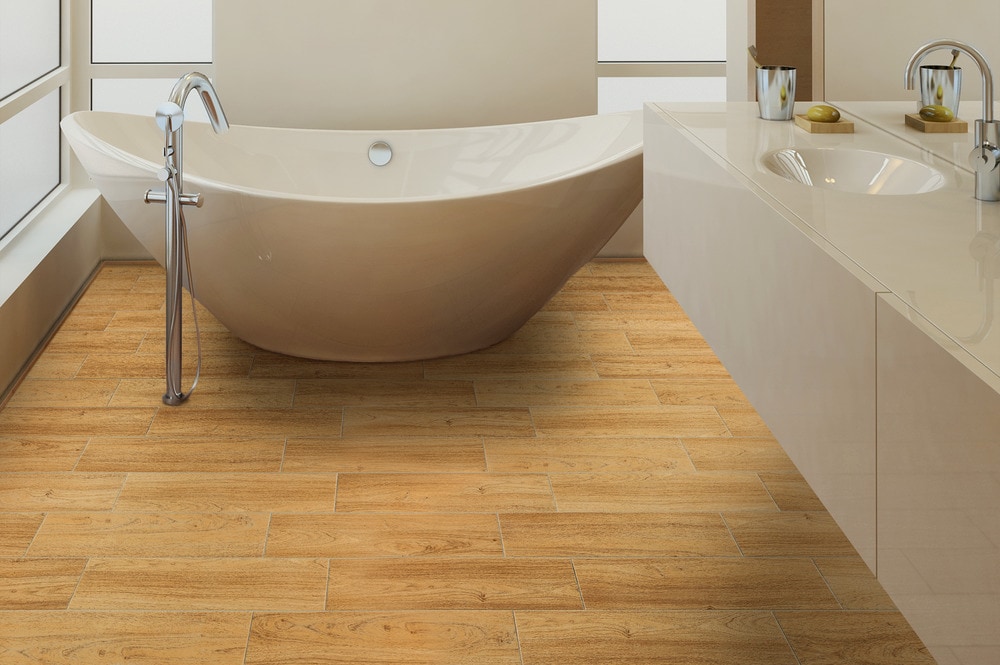Porcelain vs. Ceramic Tile: What’s the Difference?
If you haven’t purchased porcelain or ceramic tiles before, differentiating between these two materials can be tricky. They have similar qualities and look the same. To make matters even more confusing, porcelain is technically a type of ceramic. So how much of a distinction is there, really, besides the price?
The short answer is that porcelain has a higher density and greater water resistance than ceramic. It also has a more uniform color and generally has a higher durability. However, ceramic tiles are kinder to your wallet and offer many of the same benefits as porcelain. Overall, the differences aren’t huge, but they’re important enough to determine which material you should use in which part of your home. Make sure you understand the following factors before choosing ceramic or porcelain for your next home renovation project.
Cost
Ceramic tiles generally cost 60 to 70 percent less than porcelain tiles. This is due in part to the cost in material. Both ceramic and porcelain are made primarily of clay along with water and small amounts of other minerals. Porcelain, however, has fewer impurities. Its main ingredient is kaolin clay — one of the most expensive clays in the U.S. Manufacturing porcelain is also more costly because it must be fired at higher temperatures for a longer length of time.
Density
According to the American National Standards Institution (ANSI), density is one of the main ways to differentiate porcelain from ceramic. Porcelain has a higher density due to the kaolin clay’s finer particles. This is great if you’re looking for improved durability: Porcelain is less likely to chip. However, that also means it’s harder to cut. Ceramic tiles are much easier to work with if you’re planning to install them yourself.
Colors
With unglazed porcelain, the entire tile is translucent white from top to bottom. If it gets chipped, you’ll hardly notice it, and you won’t have to worry as much about repairs.
Glazed porcelain tiles and ceramic tiles (which are usually glazed) are pretty much the same, aesthetically. They have a glossy or matte finish that disguises the natural clay color beneath. This means any chips or scratches will reveal the white, red, or brown clay. However, glazed tiles provide you with different color options, including blue, black, and metallic. You can even find tiles with realistic-looking wood grain or stone patterns.
Resistance
Both ceramic and porcelain tiles are resistant to heat, rust, and water. They also insulate against electricity and are nonreactive with chemicals. The main difference is that porcelain resists water more than ceramic does. In fact, it must have a water absorption rate of 0.5 percent or lower to be classified as real porcelain, according to the American Society for Testing and Materials (ASTM). Not surprisingly, this distinction means porcelain is also less likely to get stained when someone (not you, of course!) spills coffee on the kitchen floor.
Durability
Ceramic and porcelain are both susceptible to thermal shock. Overall, though, ceramic and porcelain are highly durable. Porcelain is generally more durable because of its greater density, higher water resistance, and larger amounts of feldspar (rock-forming minerals).
Despite this fact, you’ll still need to check the tile grade to know for sure that you’re getting the right tiles for the job. Ceramic and porcelain tiles have different hardness ratings, called PEI ratings, that range from zero (suitable for wall installation) to five (suitable for floors in heavy-traffic areas). After all, it doesn’t make much sense to get PEI 5 tiles if all you want to do is add a backsplash to the kitchen.
Outdoor and Indoor Usage
Speaking of the kitchen, both ceramic and porcelain tiles are suitable for just about any room inside your home. Porcelain’s high water resistance makes it suitable for wet areas like the bathroom, mud room, or laundry room. Ceramic tiles can also work well in these areas, but you’ll need to check the water-absorption rating to make sure the material can handle it.
Aside from the traditional places to use ceramic or porcelain tiles — such as kitchens and bathrooms — you can also add them as flooring to your living room or game room for a contemporary look. If using porcelain, keep in mind that unglazed tiles are less slippery than glazed tiles. If you have rugrats running around your home in their socked feet, they will much appreciate the slip-resistant flooring!
These materials are becoming more popular for outdoor use on the deck or patio, too. This is one area where you should not install ceramic tiles. They absorb too much water, which can cause them to crack when they freeze and thaw. If you live in a warmer climate, the damage won’t be as severe. You could try it (we can’t stop you!), but most flooring experts don’t recommend it. Certain types of porcelain tiles, on the other hand, can withstand weather fluctuations better than ceramic tiles. Just make sure the product is labeled as being suitable for outdoor use.
Quality
The quality of a ceramic or porcelain tile depends on what you’re looking for. Each product is rated for different qualities such as wear resistance, water absorption, slip resistance, stain resistance, and freeze resistance. If you’re concerned about visual imperfections, check the tile grade: One is the best, and three is the worst.
A major concern in the industry is whether the porcelain on the shelf is genuine. Unfortunately, not all products labeled as porcelain are actually porcelain. Fortunately, you can look up the product line to see if it’s certified by the Porcelain Tile Certification Agency (PTCA). If so, you’re good to go. Moreover, if you’d rather go with ceramic tiles, you don’t need to even worry about certification labels.
Porcelain and ceramic tiles are similar in many ways, but they’re definitely not the same thing. Ceramic tiles are great for indoor use, especially if you’re trying to stay on a budget. Porcelain tiles are practically waterproof, making them perfect for outside use. Whatever type of tile you choose, just make sure it’s something you love.
Sources:
https://www.explainthatstuff.com/ceramics.html
https://www.thespruce.com/porcelain-tile-vs-ceramic-tile-1822583
https://minerals.usgs.gov/minerals/pubs/commodity/clays/mcs-2018-clays.pdf
https://www.hunker.com/13401232/what-is-the-difference-between-ceramic-and-porcelain-tile
https://www.homeflooringpros.com/blog-guides/porcelain-vs-ceramic-tile-whats-the-difference-between-them/






